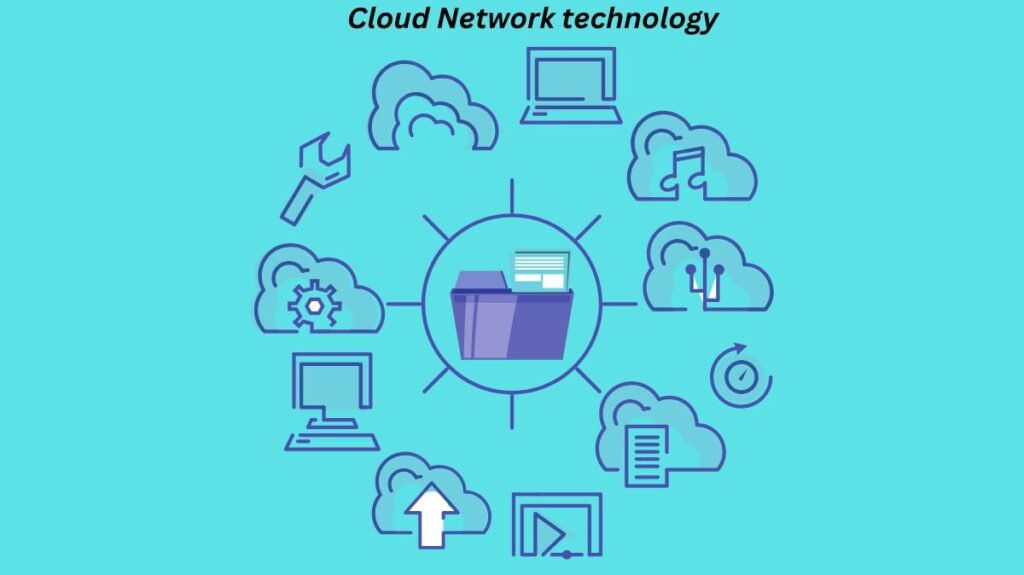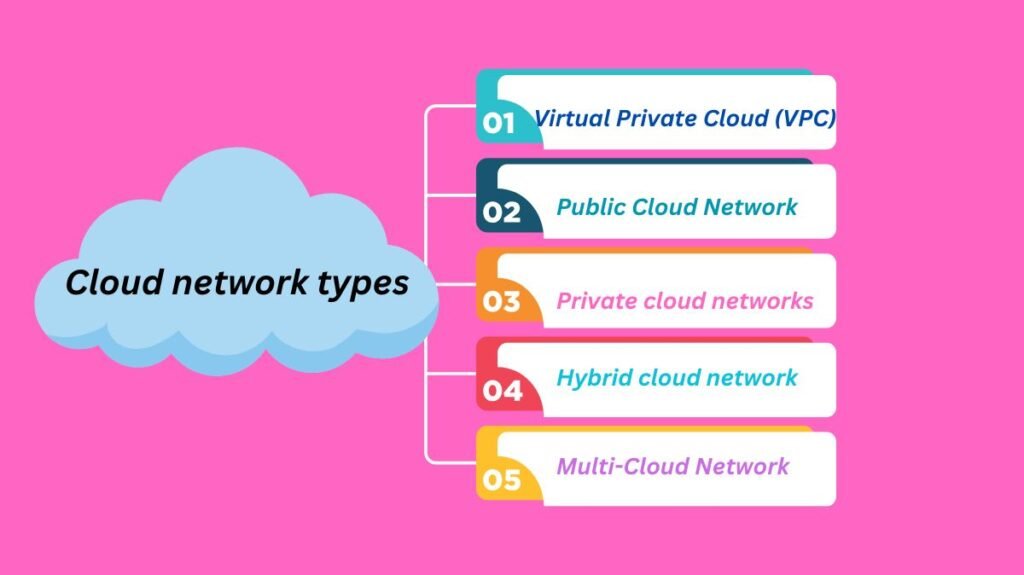Cloud Network technology
What is network in cloud computing?
In the cloud, a network is a group of linked servers, storage, and apps that are hosted online and made accessible to people everywhere. Without requiring physical infrastructure, it enables users to access and utilize computing resources and services.

Without physical infrastructure, this network lets users access databases, virtual machines, and applications.
Cloud providers ensure service availability, scalability, and security on the cloud network. Depending on user access and management, cloud networks can be public or private. Public cloud networks are managed by third-party providers, while private cloud networks are hosted and run by companies, either on-premises or third-party.
The cloud network has multiple components and data backups to reduce service outages. It manages computational resources and lets users scale up or down as needed.
How does work Cloud networks?
A network in a cloud environment often comprises of numerous networked VMs or instances hosted on physical servers in a data center. A cloud provider-created and controlled virtual network connects these instances.
Here are the basic cloud network steps:
- Virtualization: The data center’s physical infrastructure is separated into virtual computers or instances with their own CPU, memory, and storage capacities.
- A virtual network is created by the cloud provider to connect these instances. A cloud provider may manage virtual routers, switches, and firewalls in this network.
- The virtual network identifies each instance by its IP address.
- Using firewalls or security groups, the cloud provider can restrict communication between instances or networks.
- Load balancing: Multiple machines can handle user or application requests in the cloud. To improve performance and availability, load balancing technologies can spread traffic between these instances.
- Network monitoring and management: The cloud provider can track bandwidth utilization, latency, and packet loss and offer management tools to help users improve their network settings.
Why are Cloud Networks Important?
Scalability:
- Businesses can easily alter resources to meet demand with cloud networks.
- Company services can grow quickly without worrying about infrastructure.
Flexibility:
- User resources can be moved between data centers and clouds using cloud networks.
- By combining public and private clouds, companies can increase flexibility and agility.
Collaboration:
- Cloud networks make collaboration easy by letting teams access remote resources from anywhere with an internet connection.
- From any device, users can access resources independent of technology or location.
Security:
- Due to cloud network architecture’s security focus, businesses can use several tools and technologies to secure their assets and data.
- These data breach prevention options include firewalls, VPNs, identity and access management, and others.
Lower costs:
- Business capital and operating costs can be reduced using cloud networks.
- Cloud network infrastructure simplifies and lowers networking hardware and software management.
- Businesses gain from cloud providers’ economies of scale.
Examples of cloud networks
Cloud providers provide clients with a “network in the cloud.” Flexible, secure cloud app and resource connections are provided by these networks.
Virtual Private Cloud (VPC)
Virtual Private Cloud (VPC) lets customers create private networks in the public cloud. VPC customers can construct subnets, route tables, and network gateways and control resource access with security groups and network ACLs.
Load balancing
By dividing incoming traffic over numerous cloud instances, load balancing improves performance and availability. In order to boost redundancy, load balancing can distribute traffic between cloud instances in the same area and between regions or availability zones.
VPN services
Internet-based VPN services from cloud providers allow users to securely access their cloud resources. Remote users or branch offices can use VPNs to securely connect to cloud services using encryption and authentication.
Direct Connect
Direct Connect lets clients connect their on-premises equipment to the cloud provider’s data center. A safe, high-bandwidth link between on-premises and cloud resources can transmit huge amounts of data.
Network function virtualization (NFV)
Network function virtualization (NFV) lets users build and operate firewalls, load balancers, and routers without hardware. The cloud-deployed software lets customers manage their network architecture more adaptably and scalable.
Cloud network types

The cloud uses numerous sorts of networks. These are:
Virtual Private Cloud (VPC): Customers can establish their own private network in the cloud with a VPC. Cloud instances, load balancers, and databases can be linked securely.
Public Cloud Network: Websites, APIs, and other public resources are hosted on the public cloud network.
Private cloud networks: These are used for internal software and services and can only be accessed securely.
Hybrid cloud network: Some resources are hosted in the public cloud and others in the private cloud in a hybrid cloud network. With this network, enterprises may use the public cloud’s scalability and cost-effectiveness while keeping control over critical data and applications.
Multi-Cloud Network: A multi-cloud network connects multiple clouds to give users access to each one’s benefits and talents while preventing vendor lock-in andmaximizing robustness and redundancy.
The proper network for your firm depends on your goals and requirements. Every network type has advantages and disadvantages.
Cloud network components
A scalable, secure, and high-performing cloud network often includes several critical components.
- A virtual private cloud (VPC) provides a private, isolated, and secure cloud environment. It allows users to construct private networks, specify subnets, IP addresses, and routing tables, and secure network access.
- For better organization, management, and security, subnets divide a VPC into smaller subnetworks. Cloud providers’ availability zones or regions usually correlate to subnets.
- A virtual router that links a VPC to the internet is called an Internet Gateway. This allows users to access VPC resources from the internet or VPC resources to access internet services.
- VPC load balancers spread network traffic across several instances or services. Balancing traffic load and offering fault tolerance improves cloud application and service performance, scalability, and availability.
- NACLs: VPC subnet-level security rules manage inbound and outbound traffic. Their network security goes beyond security groups, which control instance traffic.
- Virtual firewalls called security groups govern VPC instance-level incoming and outbound traffic. They allow instance, port, and protocol-specific network access.
- Direct link allows users to link their on-premises data center to a cloud VPC. It is more reliable, faster, and secure than internet connections.
Cloud networking challenges?
Implementing and managing cloud-based networks might be difficult, but they have many benefits. Common problems:
- Network Performance: High network traffic and latency can strain cloud-based networks. Without proper resource provisioning, cloud providers’ shared infrastructure might cause unexpected performance.
- DDoS assaults, data breaches, and illegal access can threaten cloud-based networks. Encryption, access controls, and network segmentation are needed to secure data and network resources.
- For enterprises with several VPCs or hybrid cloud setups, cloud-based networks can be complicated. Traffic, routing tables, security groups, and access controls across environments are difficult to manage without specialist knowledge.
- Organizations that mismanage their cloud resources can incur high costs. Monitoring utilization and optimizing resources can help firms control the cost of data transport, network storage, and other network services.
- Lock-in: Cloud providers may offer proprietary network services or technologies that make it hard for enterprises to transfer providers or relocate their network infrastructure.
- Deploying cloud-based networks requires compliance with PCI DSS, HIPAA, and GDPR. Compliance can complicate and cost network implementations and require an expert.
Best practices for cloud networks:
- Strategize network architecture for scalability, security, and compliance.
- Apply security groups, ACLs, and firewall rules to segment networks.
- Secure on-premises-cloud connectivity with VPN or direct connection.
- Monitoring network performance with cloud-based technologies helps troubleshoot.
- Manage scale efficiently with automation and orchestration.
- For easier deployment and management, adopt DevOps.
- Set up security procedures to meet industry and regulatory requirements.


[…] Infrastructure that is varied: Cloud servers’ computing infrastructure can be either virtual, physical, or both, depending on the use cases and specifications of the cloud computing environment. […]
[…] cloud providers have extensive networks of physical data centers. Servers, storage devices, and network equipment are examples of the physical hardware and software tools that underpin public cloud […]